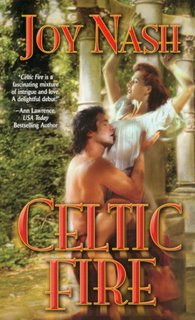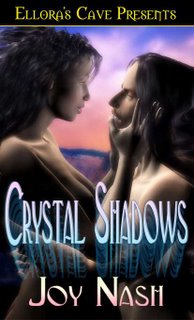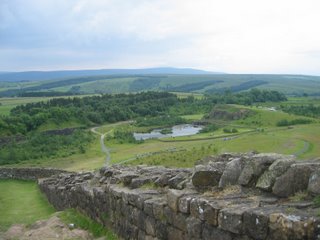***Joy's Book Link***
In The Grail King, Clara's father is the legate (commander) of the Roman Fortress at Isca Silurum. The Aquila farm, where Marcus lives with his father and stepmother (Lucius and Rhiannon from Celtic Fire), is in the countryside nearby. A pivotal scene in The Grail King takes place in the Roman amphitheater just outside the fortress walls.
Okay, first off, I've heard from more than one person who thinks I'm still in the UK! Unfortunately, not true, this trip is long over. It started June 23 and ended July 7, 2006. I'm still working in getting the pics and commentary online. I know that's not quite in the spirit of blogging, which is supposed to be real time, but it's the best I can do. My Immortals: The Awakening deadline is fast approaching (Oct 16) but I swear I'm going to get to the end of my vacation pics in the next week or two.
Day Nine was one I'd really been locking forward to. Not only was I going to get to see the location I'd picked for a large part of The Grail King, but as luck would have it, the Roman Museum in Caerleon was having its Living History weekend during our visit! I was beyond thrilled.
The town of Caerleon, Wales, just outside of Newport, is built right on the foundations of the Roman Fortress of Isca Silurum, which was one of the three major Roman fortresses in Britannia. The other two were at Londinium (London) and Eburacum (York). It's the only place in England where you can see excavations of a Roman Army barracks. Only a portion of the fortress and the surrounding wall has been excavated on the edge of town, because you'd have to tear down the entire medieval city to get at the rest of it. Isca Silurnam was a very big fortress. There would have been over 5,000 soldiers stationed there. Probably just as many civilians--tradespeople and families of the soldiers--lived outside the walls. Roman footsoldiers weren't allowed to marry, but many of them had unofficial wives and children that traveled with them to their various posts. In The Grail King, Clara's father was the commander (or legate) of the fortress. She would have lived in a very posh commander's residence (with a courtyard, central heat, running water and private bathing rooms) in the center of the fortress.
Just outside the fortress walls, there was a Roman amphitheater. This would have been used for all sorts of military and civilian functions. The site has been excavated and is used for presentations and shows today. There's a flat grassy area in the center, and a higher oval of grass on top of what used to be the seating area. This is where the living history festival was going on.
The main presenters were The Ermine Street Guard, a London-based Roman Military Re-enactors' Group that is the largest club of this kind in the world. In the US, we have obsessed Civil War re-enactors, in England they have obsessed Roman re-enactors. These guys make their own armor and weapons, cook Roman food, erect Roman tents, and put on a great show. There was a live military presentation complete with cavalry and catapults. Here's a pic of the army in formation:
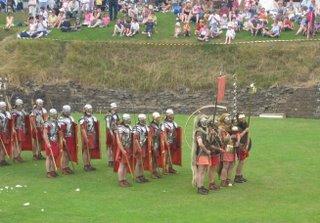
Set up nearby was a city of tents in which just about every aspect of Roman military and civilian frontier life was presented: food, tools, blacksmithing, leatherworking, medicine, cosmetics, textiles, glassmaking, toys, you name it, they had it there. The men were great and loved talking about their hobby. Several of them had wives and kids along to help with various presentations. They all loved to talk. Two of the soldiers spent some time with me explaining the relative merits and disadvantages of the Auxiliary Troops' chain mail versus the Legionaries' segmented armor. Here's me and a Roman Signifer (standard-bearer). I hope that's not a real wolf on his head!
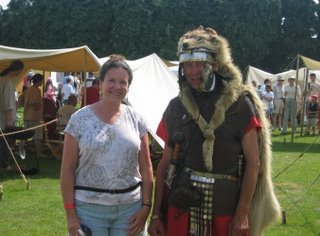
But what would a Roman Amphitheatre be without a gladiator or two? Luckily, there were a whole group of gladiators, members of a troop of Italian gladiator re-enactors from Rome, Italy. These guys were serious athletes who put on a great show, boxing, fighting with swords, or entrapping their victim with trident and net. When a man went down, the audience got to chose whether he lived or died. One poor guy got a very realistic sword in the belly. Don't worry, he walked away from the show unscathed. Here's a pic of the gladiators preparing for action. Can you say HOT???:

And after the show, here are the hotties resting in the shade:

Whoa, baby!
Next up: Bath, England
Later...
Joy
www.joynash.com

